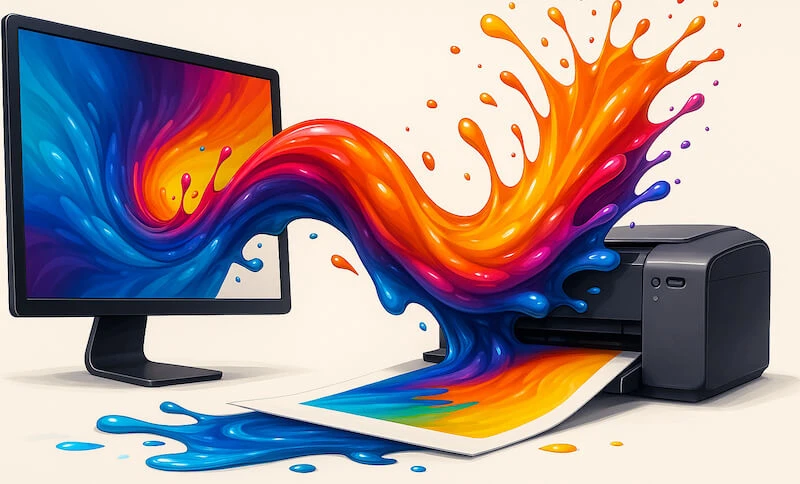When you design a colorful image on your computer, you expect it to look the same when printed. But in sublimation printing, that’s rarely what happens, colors often appear dull, faded, or completely off. The reason lies in something most beginners overlook: color profiles.
A color profile (technically known as an ICC profile) is a digital “translation guide” that helps your computer, design software and printer interpret colors in the same way. It defines how colors are represented within a device’s specific color space.
Why Sublimation Colors Don’t Always Match What You See on ScreenYour monitor shows colors in RGB, a light-based system, while sublimation printers use CMYK, a pigment-based one. During sublimation, heat turns ink into gas and embeds it into polyester fibers, which can shift tones depending on temperature, material density, and paper quality. These color space differences and heat effects explain why colors often change between your digital design and the final print.

In sublimation printing, accurate color management depends on using the correct ICC profile for your printer model, ink type, and sublimation paper. Without proper color profiling, even professional designs can produce inconsistent or inaccurate results.
This article explains what color profiles are, how they work, and why they’re critical for achieving predictable, professional color reproduction in sublimation printing. You’ll also learn practical steps to set them up, calibrate your monitor, and troubleshoot color mismatches.
Key Takeaways
Color profiles standardize color interpretation.
They ensure your printer and monitor “speak the same language” so printed colors match what you see on screen.
ICC profiles are device-specific.
Always use the ICC file recommended for your printer, sublimation ink, and paper combination.
Monitor calibration matters.
An uncalibrated display can cause inaccurate color expectations, even with perfect print settings.
Consistent workflow = consistent color.
Keep the same settings, paper, and press temperature once you’ve achieved accurate results.
Color management builds trust.
Reliable color output improves product quality, customer satisfaction, and your overall brand credibility.
How Color Profiles Ensure Accurate Color Reproduction
A color profile defines how colors are interpreted as they move from a digital design (RGB light on a screen) to printed output (CMYK dye on a substrate). Each device, a monitor, design software, printer, speaks a slightly different “color language.” Without a profile, every device makes assumptions, which leads to unpredictable shifts: tones appear dull, shadows muddy, and bright colors lose vibrancy after heat transfer.
A profile works by mapping the color gamut of each device. It translates the screen’s wide range of colors into the more limited range that sublimation dye can physically reproduce. This mapping ensures consistent output and maintains tonal integrity, so what you see during design aligns closely with what appears on the final surface.
In practice, the profile acts as a color translation guide. It tells the printer how to convert each pixel value into the correct formulation of ink during sublimation. Instead of guessing, the printer receives precise instructions, resulting in predictable results and a closer screen-to-print match.
| 💡 What exactly is a color profile?A color profile (ICC profile) is a small digital file that defines how a device interprets color. It translates the colors you see on an RGB screen into the CMYK dye output your sublimation setup can reproduce, so each device uses the same color information. |
Why ICC Profiles Must Match Your Printer, Ink, and Paper
An ICC profile must reflect the exact printing setup because every component introduces hardware variability. Printers, ink formulations, and coated sublimation papers each handle color differently. These differences change the available color pathway, the range of tones the system can reproduce.
The ICC profile works like a color translation table (LUT). It tells the printer driver how to render each color value based on that specific combination of ink chemistry and media type. If the profile doesn’t match the setup, the printer guesses, leading to color shifts and unpredictable results.
Even though paper brands vary, sublimation paper shares consistent coating behavior. The profile is tuned to how dye interacts with coated media and the final substrate (polyester fabric, hard blanks, etc.). This is why profiles focus on ink + printer behavior, not the exact paper brand.
The Role of Monitor Calibration in Color Accuracy
A printer can only reproduce what the monitor displays. If the screen shows inaccurate color, the print will be inaccurate, even with the correct ICC profile. Monitor calibration ensures the display shows colors at a known visual baseline, so the design reflects real output potential.
Uncalibrated screens are usually too bright and oversaturated. This distorts color perception, making prints appear darker or dull by comparison. Calibration adjusts the screen’s brightness level, white point (often D65), and gamma, so design decisions are based on accurate reference values rather than guesswork.
Calibration creates display uniformity across devices and enables effective soft proofing, previewing how colors will translate to printed output. When the monitor is accurate, the printer doesn’t need to compensate for misleading screen values, which reduces waste and reprints.
| 💡 How do you calibrate a monitor for accurate color?You can calibrate a monitor using hardware or software. A hardware calibrator (like X-Rite or Spyder) measures color directly from the screen and automatically applies accurate corrections. Software calibration uses system tools to set standard values, brightness around 70–80%, white point D65 (6500K), and gamma 2.2. Hardware measures color objectively; software applies known standards without relying on your eyes. |
Color Accuracy Comes from a Controlled, Repeatable Workflow
Accurate color depends on workflow discipline, not guesswork. Sublimation has multiple variables, press temperature, dwell time, pressure, media type, and substrate coating, and each affects dye behavior during heat transfer. If these conditions change from job to job, color results vary, even when using the correct ICC profile.
A repeatable workflow keeps the print pipeline predictable. Using the same presets in your design software and printer driver, the same media type, and the same press settings reduces variability. When every step is consistent, the printer applies ink the same way, the coating releases dye the same way, and the substrate absorbs color the same way. This creates uniform output across batches.
Reliable Color Builds Quality, Efficiency, and Customer Confidence
Consistency in color output is one of the simplest ways to avoid common sublimation print failures. When your process remains stable, it becomes more efficient, reducing reprints, wasted blanks, and ink consumption while ensuring every product meets its visual standard. Stable color output also supports quality assurance because every product matches the expected visual standard.
Reliable color builds brand integrity. When customers reorder an item, they expect the same shade, tone, and vibrancy. Uniform output reinforces trust in your process and product, whether you’re producing a single custom item or fulfilling repeat orders.
Related Topics
